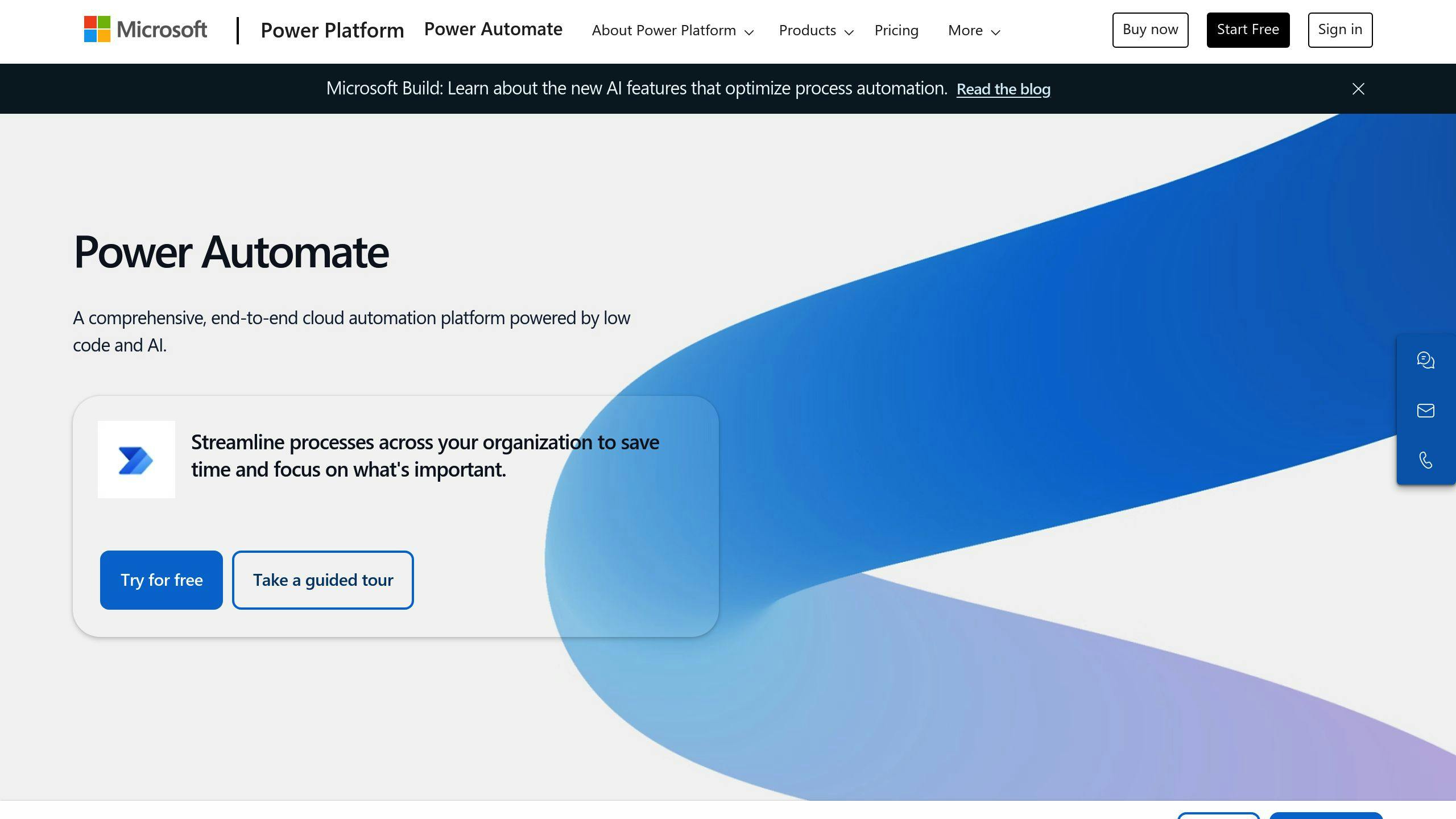Task assignment templates in Microsoft Teams can revolutionize your project management. Here’s what you need to know:
- Templates cut project setup time by 88%
- They ensure consistency across teams
- You can customize templates for specific needs
- Templates integrate with Planner and To Do
Key benefits:
- Faster project launches
- Fewer missed steps
- Better team collaboration
- Easy adaptation to different projects
How to set up templates:
- Open Teams and go to your channel
- Click "+" and select "Planner"
- Create a new plan
- Add tasks, due dates, and roles
- Use buckets to organize tasks
Pro tip: Use Power Automate to create workflows that automate repetitive tasks.
Quick Comparison:
| Feature | Without Templates | With Templates |
|---|---|---|
| Setup Time | Hours | Minutes |
| Consistency | Variable | High |
| Task Tracking | Manual | Automated |
| Tool Integration | Limited | Seamless |
By using task templates in Teams, you’ll spend less time planning and more time doing.
Related video from YouTube
What Are Task Assignment Templates?
Task assignment templates in Microsoft Teams are pre-made task lists that make project management easier and help teams work better. They’re like a starting point for projects, making sure you don’t miss important steps.
Core Functions
Here’s what task templates do:
- They keep things consistent for projects you do often
- They save time by not having to make new task lists every time
- They help teams start quickly and stay organized
- You can change them to fit your specific project needs
Main Advantages
Using these templates has some big benefits:
1. Faster Setup
Teams can start projects 88% faster. That could save over $10,000 in labor costs if you’re making 20 new Teams each month.
2. Fewer Mistakes
With pre-made task lists, you’re less likely to forget important steps.
3. Better Teamwork
Templates show everyone what needs to be done, so teams work together better.
4. Easy to Adapt
While templates give structure, you can easily change them to fit your project.
Available Template Options
Teams has different templates for various project types:
| Template Type | What It’s For | Who It’s For |
|---|---|---|
| Project Management | Big projects with multiple stages | Teams handling complex projects |
| Software Development | Building and launching software | IT and dev teams |
| Business Plans | Planning new businesses or expansions | Startups and growing companies |
| Employee Onboarding | Getting new hires up to speed | HR and management |
Working with Planner and To Do
These templates work great with Microsoft Planner and To Do:
1. Using Planner in Teams
- Add Planner to Teams by searching for it in "View more apps"
- Make shared plans right in the app
- See all your plans in one place with "My Plans"
2. Syncing with To Do
- Tasks you get in Planner show up in your To Do list
- Use "My Day" in To Do to focus on today’s tasks
- "My Tasks" in Planner shows all your tasks in one spot
By using these together, you can keep track of team projects and your own tasks without missing anything.
A Microsoft product manager says: "Task templates in Teams mean you don’t have to start from zero every time, making it much easier to manage tasks."
These templates, plus Planner and To Do, give you powerful tools to manage tasks across your whole organization.
How to Set Up Task Templates
Want to save time and streamline your workflow in Microsoft Teams? Task templates are the way to go. Here’s how to set them up:
Finding Template Tools
First, you need to get to the right place in Teams:
- Open Microsoft Teams
- Go to your team or channel
- Click the "+" next to Tabs
- Pick "Planner" from the app list
Basic Setup Steps
Now, let’s create a basic task template:
- In Planner, hit "New Plan"
- Name it (like "Marketing Campaign Template")
- Click "Create Plan"
- Add tasks with the "+ Add Task" button
- For each task, fill in:
- Task name
- Who’s responsible
- When it’s due
- Any extra details or files
Adding Custom Fields
Make your template fit your team’s needs:
- Open a task’s details
- Scroll to "Add a field"
- Pick from options like Priority, Progress, Start date, Checklist, or Notes
Pro tip: Use the same custom fields across tasks. It’ll make your life easier when you need to report or filter later.
Setting Default Tasks
To create a template you can reuse:
- Add all the usual tasks for your project type
- Set relative due dates (like "3 days after project start")
- Use roles instead of names (e.g., "Marketing Lead" not "Jane")
This way, your template stays flexible for different projects.
Managing Access Rights
Control who can mess with your templates:
- Go to your Planner tab
- Click "…" next to your plan
- Pick "Plan settings"
- Choose who can edit: Everyone, Only owners, or Specific people
"Task templates in Teams are a game-changer. You’re not starting from scratch every time, which makes task management so much smoother." – Microsoft product manager
Power Up with Automation
Want to take it further? Use Power Automate:
- Find "Automate" in Teams
- Click "Create from template"
- Look for task-related templates
- Connect your Teams and Planner accounts
Here’s a quick look at what Power Automate can do:
| Trigger | Action | Result |
|---|---|---|
| New channel message | Create a task | Important messages become tasks automatically |
| Task done | Post to chat | Team knows when tasks are completed |
| Due date coming up | Send email | No one forgets about their tasks |
With these steps, you’ll be a task template pro in no time. Your team will thank you for making everyone’s life easier!
Setting Up Task Workflows
Let’s dive into how you can supercharge your productivity with task workflows in Microsoft Teams.
Creating Automatic Assignments
Want to save time and cut down on errors? Here’s how to automate task assignments:
- Open Microsoft Planner in Teams
- Create a new task or select an existing one
- Click on the "Assigned to" field
- Choose "Assign by rule" instead of a specific person
- Set up your rule (e.g., assign to the person with the least tasks)
Now your tasks will be distributed automatically and fairly. No more manual assignments!
Using Power Automate

Power Automate can take your task management to the next level. Here’s how to get started:
- Go to the "Automate" tab in Teams
- Click "Create from template"
- Search for task-related templates
- Connect your Teams and Planner accounts
Check out these cool automations you can set up:
| Trigger | Action | Result |
|---|---|---|
| New email | Create task | Important emails become tasks |
| Task completed | Post in channel | Team stays updated on progress |
| Approaching deadline | Send reminder | Tasks get done on time |
Setting Up Rules
Rules in Planner help keep your task management consistent. Here’s how to create one:
- In Planner, click the "Automation" tab
- Select "+ New Rule"
- Name your rule
- Set the conditions and actions
For example, you could make a rule that assigns all "Urgent" tasks to your team lead automatically.
Setting Up Alerts
Don’t let tasks slip through the cracks. Set up alerts to keep everyone in the loop:
- In Planner, go to "Settings"
- Select "Notifications"
- Choose which events trigger alerts (e.g., task assigned, due date approaching)
- Pick how you want to receive alerts (email, Teams message)
"Automation in Teams has been a game-changer for us. We’ve seen a 30% reduction in missed deadlines since implementing automated alerts." – Sarah Johnson, Project Manager at TechCorp
Regular Task Setup
Got tasks that happen on a schedule? Use recurring tasks:
- Create a new task in Planner
- Click on "Set due date"
- Select "Repeat"
- Choose your preferred recurrence pattern (daily, weekly, monthly, etc.)
This is perfect for things like weekly team updates or monthly reports. Set it up once, and you’re good to go!
sbb-itb-8be0fd2
Taking Care of Templates
Keeping your Microsoft Teams task templates organized is key to staying efficient. Here’s how to manage them like a pro:
Keeping Templates Organized
Want to find your templates fast? Try this:
- Name them consistently (like "Marketing_Campaign_Template")
- Create a special channel just for templates
- Use tags to sort them by project type or department
Making Template Changes
Need to update a template? Here’s how:
1. Open the template in Planner
2. Click "…" next to the plan name
3. Hit "Copy plan"
4. Tweak the copy
5. Give it a new name (maybe "Marketing_Campaign_Template_v2")
This way, you keep the original and get to improve it.
Tracking Template Changes
To keep up with template updates:
- Add version numbers to template names
- Start a change log in a Teams wiki tab
- Write down big changes, why you made them, and when
Creating Multiple Tasks
Want to create tasks quickly? Here’s a trick:
1. Open your template in Planner
2. Hold Ctrl (or Cmd on Mac) and click to select multiple tasks
3. Click "Copy tasks" at the top
4. Pick where you want them and hit "Copy"
Now you can fill new projects with template tasks in no time.
Removing Old Templates
Keep your template library tidy:
- Look over your templates every few months
- Move unused ones to a separate plan
- After 6 months of no use, it’s time to say goodbye
"We’ve cut our project setup time by 40% and our teams are more consistent now that we’re on top of our templates", says Sarah Johnson, Project Manager at TechCorp.
| Template Management Tips |
|---|
| Name them clearly |
| Store in one place |
| Update regularly |
| Track changes |
| Clean out the old ones |
Tips for Better Results
Want to make your Microsoft Teams task management even better? Here are some tips to get the most out of your task templates:
Naming Your Templates
Good template names make life easier. Here’s how to do it:
- Stick to a pattern (like "[Department]_[Project Type]_Template")
- Add version numbers (e.g., "Marketing_Campaign_v2")
- Keep it short and sweet, but clear
Writing Clear Tasks
Vague tasks? No thanks. Here’s how to write tasks everyone understands:
- Start with action words ("Create", "Review", "Submit")
- Be specific ("Design 3 logo concepts" beats "Work on logo")
- Include context or needed resources
Setting Task Priorities
Some tasks matter more than others. Here’s how to show it:
| Priority | What It Means | Example |
|---|---|---|
| High | Do it now | Client presentation tomorrow |
| Medium | Important, but can wait a bit | Weekly team report |
| Low | Nice to do, not crucial | Future project brainstorm |
Use these levels in all your templates. It helps your team focus on what’s important.
Template Rules
Want to keep things organized? Follow these rules:
1. Check regularly: Look over your templates each month. Are they still good?
2. Ask for feedback: Your team might have great ideas to make templates better.
3. New changes? New version: Big updates mean it’s time for a new template version.
4. Keep track: Write down what you change and why. It helps later.
Making Templates Work Better
Good templates can always be better. Try these ideas:
- Use Power Automate: Set up workflows to handle repetitive stuff automatically.
- Add custom fields: Things like "Estimated time" or "Dependencies" give more info.
- Use tags: They make it easier to sort and find tasks.
"We started using task templates and these tips. Now we set up projects 25% faster and finish 15% more tasks on time." – Sarah Johnson, Project Manager at TechCorp
Using nBold with Task Templates

nBold supercharges task templates in Microsoft Teams. Here’s how it can boost your productivity:
Making Custom Templates
With nBold, you’re not just creating task lists. You’re building entire project ecosystems:
- Clone everything: tasks, team structures, channels (standard and private), tabs, and team settings.
- Customize templates to fit your exact workflow.
Here’s what users are saying:
"nBold cut our project setup time by 60% and made our teams more consistent", – Mark Thompson, IT Director at TechInnovate Inc.
Adding Other Apps
nBold plays well with others:
- Plug your go-to productivity tools right into Teams templates.
- Use Power Automate with nBold for slick automated workflows.
- Got the nBold CRM plan? Integrate your customer management tools directly.
Keeping Templates Secure
For big organizations, security is key. nBold’s got you covered:
- Set rules for naming, targeting, and approvals to keep Teams organized and compliant.
- Control who can make, edit, and use templates.
- Track template changes and usage for accountability.
nBold doesn’t just make templates. It creates a whole new way to manage tasks in Teams. Give it a shot and see how it transforms your workflow.
Conclusion
Task assignment templates in Microsoft Teams have changed the game for project management and team collaboration. Here’s what you need to know:
Templates slash setup time. Microsoft says teams create new projects 88% faster with templates. For companies starting 20 new Teams each month, that’s over $10,000 saved in labor costs.
They also bring consistency. This is huge for big teams spread across different departments or locations. No more confusion or errors from inconsistent setups.
But don’t worry – templates aren’t rigid. You can still tweak them to fit your project’s needs. It’s the best of both worlds: structure when you need it, flexibility when you don’t.
The real power comes from integration. These templates work seamlessly with other Microsoft tools like Planner and To Do. It’s like having a Swiss Army knife for task management.
And let’s talk automation. With Power Automate, you can set up some pretty cool workflows. Imagine tasks automatically created from important emails or deadline reminders sent without you lifting a finger.
Here’s a quick before-and-after:
| Aspect | Before Templates | With Templates |
|---|---|---|
| Project Setup Time | Hours | Minutes |
| Consistency Across Teams | Variable | High |
| Task Tracking | Manual | Automated |
| Integration with Other Tools | Limited | Seamless |
Want to make the most of these templates? Here are some tips:
- Keep them up-to-date
- Get your team involved in creating them
- Use clear, action-oriented task names
- Set realistic deadlines
- Use automation to handle repetitive tasks
The bottom line? Less time setting up, more time getting stuff done. As Sarah Johnson from TechCorp put it: "We’ve cut our project setup time by 40% and our teams are more consistent now that we’re on top of our templates."
Looking to level up even more? Check out tools like nBold. They can supercharge your template game in Microsoft Teams, letting you clone entire project setups and even integrate with CRM systems.
FAQs
Here are some common questions about task assignment templates in Microsoft Teams:
How to make a task template in Teams?
Making a task template in Teams is pretty simple:
- Open Teams and go to your team
- Click "+" in the channel you want
- Pick "Planner" from the options
- In Planner, hit "Create a new plan"
- Name your plan (like "Marketing Campaign Template")
- Add tasks, due dates, and roles (not specific people)
- Use buckets to group tasks
"Task templates cut our setup time by 40%. We can focus on doing the work instead of planning it", says Sarah Johnson, Project Manager at TechCorp.
How to create a task list in Microsoft Teams?

Want to make a quick task list from a chat? Here’s how:
- Go to the chat you want
- Click "…" next to the text you’re turning into a task
- Pick "Create task"
- Set the title, priority, and due date
- Hit "Add task"
You’ll find the task in "Tasks by Planner and To Do."
Need a bigger task list? Here’s what to do:
1. Open Planner
Click the "+" in your channel and choose "Planner".
2. Create a plan
Name it after your project or workflow.
3. Add tasks
Click "+" next to "Tasks" and fill in the details.
4. Organize
Use buckets to group related tasks.
5. Assign and schedule
Set owners and due dates for each task.
This way, you’ll have a clear, organized list of everything that needs to get done.
